Functional interactions between the ciliopathy-associated Meckel syndrome 1 (MKS1) protein and two novel MKS1-related (MKSR) proteins
- PMID: 19208769
- PMCID: PMC2720918
- DOI: 10.1242/jcs.028621
Functional interactions between the ciliopathy-associated Meckel syndrome 1 (MKS1) protein and two novel MKS1-related (MKSR) proteins
Abstract
Meckel syndrome (MKS) is a ciliopathy characterized by encephalocele, cystic renal disease, liver fibrosis and polydactyly. An identifying feature of MKS1, one of six MKS-associated proteins, is the presence of a B9 domain of unknown function. Using phylogenetic analyses, we show that this domain occurs exclusively within a family of three proteins distributed widely in ciliated organisms. Consistent with a ciliary role, all Caenorhabditis elegans B9-domain-containing proteins, MKS-1 and MKS-1-related proteins 1 and 2 (MKSR-1, MKSR-2), localize to transition zones/basal bodies of sensory cilia. Their subcellular localization is largely co-dependent, pointing to a functional relationship between the proteins. This localization is evolutionarily conserved, because the human orthologues also localize to basal bodies, as well as cilia. As reported for MKS1, disrupting human MKSR1 or MKSR2 causes ciliogenesis defects. By contrast, single, double and triple C. elegans mks/mksr mutants do not display overt defects in ciliary structure, intraflagellar transport or chemosensation. However, we find genetic interactions between all double mks/mksr mutant combinations, manifesting as an increased lifespan phenotype, which is due to abnormal insulin-IGF-I signaling. Our findings therefore demonstrate functional interactions between a novel family of proteins associated with basal bodies or cilia, providing new insights into the molecular etiology of a pleiotropic human disorder.
Figures
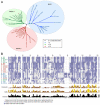
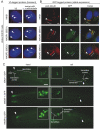
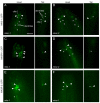
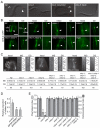

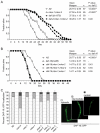
Similar articles
-
Ciliogenesis in Caenorhabditis elegans requires genetic interactions between ciliary middle segment localized NPHP-2 (inversin) and transition zone-associated proteins.J Cell Sci. 2012 Jun 1;125(Pt 11):2592-603. doi: 10.1242/jcs.095539. Epub 2012 Mar 5. J Cell Sci. 2012. PMID: 22393243 Free PMC article.
-
MKS and NPHP modules cooperate to establish basal body/transition zone membrane associations and ciliary gate function during ciliogenesis.J Cell Biol. 2011 Mar 21;192(6):1023-41. doi: 10.1083/jcb.201012116. J Cell Biol. 2011. PMID: 21422230 Free PMC article.
-
Disruption of Mks1 localization to the mother centriole causes cilia defects and developmental malformations in Meckel-Gruber syndrome.Dis Model Mech. 2011 Jan;4(1):43-56. doi: 10.1242/dmm.006262. Epub 2010 Nov 2. Dis Model Mech. 2011. PMID: 21045211 Free PMC article.
-
Meckel syndrome: genetics, perinatal findings, and differential diagnosis.Taiwan J Obstet Gynecol. 2007 Mar;46(1):9-14. doi: 10.1016/S1028-4559(08)60100-X. Taiwan J Obstet Gynecol. 2007. PMID: 17389183 Review.
-
The ciliary transitional zone and nephrocystins.Differentiation. 2012 Feb;83(2):S91-6. doi: 10.1016/j.diff.2011.11.006. Epub 2011 Dec 12. Differentiation. 2012. PMID: 22169048 Review.
Cited by
-
Drosophila chibby is required for basal body formation and ciliogenesis but not for Wg signaling.J Cell Biol. 2012 Apr 16;197(2):313-25. doi: 10.1083/jcb.201109148. J Cell Biol. 2012. PMID: 22508513 Free PMC article.
-
Small GTPases and cilia.Protein Cell. 2011 Jan;2(1):13-25. doi: 10.1007/s13238-011-1004-7. Epub 2011 Feb 20. Protein Cell. 2011. PMID: 21337006 Free PMC article. Review.
-
Ciliogenesis in Caenorhabditis elegans requires genetic interactions between ciliary middle segment localized NPHP-2 (inversin) and transition zone-associated proteins.J Cell Sci. 2012 Jun 1;125(Pt 11):2592-603. doi: 10.1242/jcs.095539. Epub 2012 Mar 5. J Cell Sci. 2012. PMID: 22393243 Free PMC article.
-
Cell- and subunit-specific mechanisms of CNG channel ciliary trafficking and localization in C. elegans.J Cell Sci. 2013 Oct 1;126(Pt 19):4381-95. doi: 10.1242/jcs.127274. Epub 2013 Jul 25. J Cell Sci. 2013. PMID: 23886944 Free PMC article.
-
Diverse cell type-specific mechanisms localize G protein-coupled receptors to Caenorhabditis elegans sensory cilia.Genetics. 2014 Jun;197(2):667-84. doi: 10.1534/genetics.114.161349. Epub 2014 Mar 18. Genetics. 2014. PMID: 24646679 Free PMC article.
References
-
- Alexiev, B. A., Lin, X., Sun, C. C. and Brenner, D. S. (2006). Meckel-Gruber syndrome: pathologic manifestations, minimal diagnostic criteria, and differential diagnosis. Arch. Pathol. Lab. Med. 130, 1236-1238. - PubMed
-
- Ansley, S. J., Badano, J. L., Blacque, O. E., Hill, J., Hoskins, B. E., Leitch, C. C., Kim, J. C., Ross, A. J., Eichers, E. R., Teslovich, T. M. et al. (2003). Basal body dysfunction is a likely cause of pleiotropic Bardet-Biedl syndrome. Nature 425, 628-633. - PubMed
-
- Apfeld, J. and Kenyon, C. (1999). Regulation of lifespan by sensory perception in Caenorhabditis elegans. Nature 402, 804-809. - PubMed
-
- Arts, H. H., Doherty, D., van Beersum, S. E., Parisi, M. A., Letteboer, S. J., Gorden, N. T., Peters, T. A., Marker, T., Voesenek, K., Kartono, A. et al. (2007). Mutations in the gene encoding the basal body protein RPGRIP1L, a nephrocystin-4 interactor, cause Joubert syndrome. Nat. Genet. 39, 882-888. - PubMed
Publication types
MeSH terms
Substances
Grants and funding
LinkOut - more resources
Full Text Sources
Molecular Biology Databases
Research Materials

